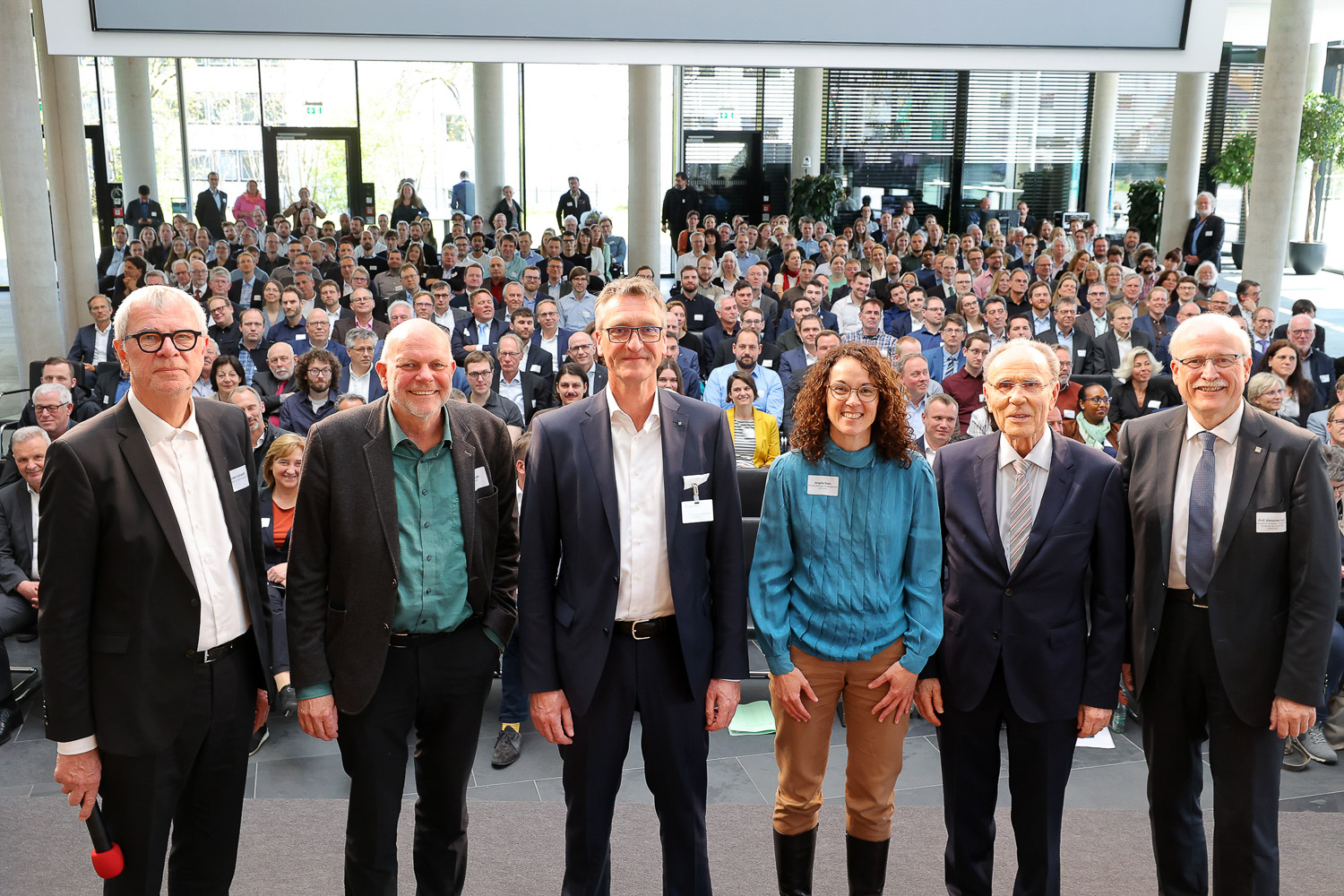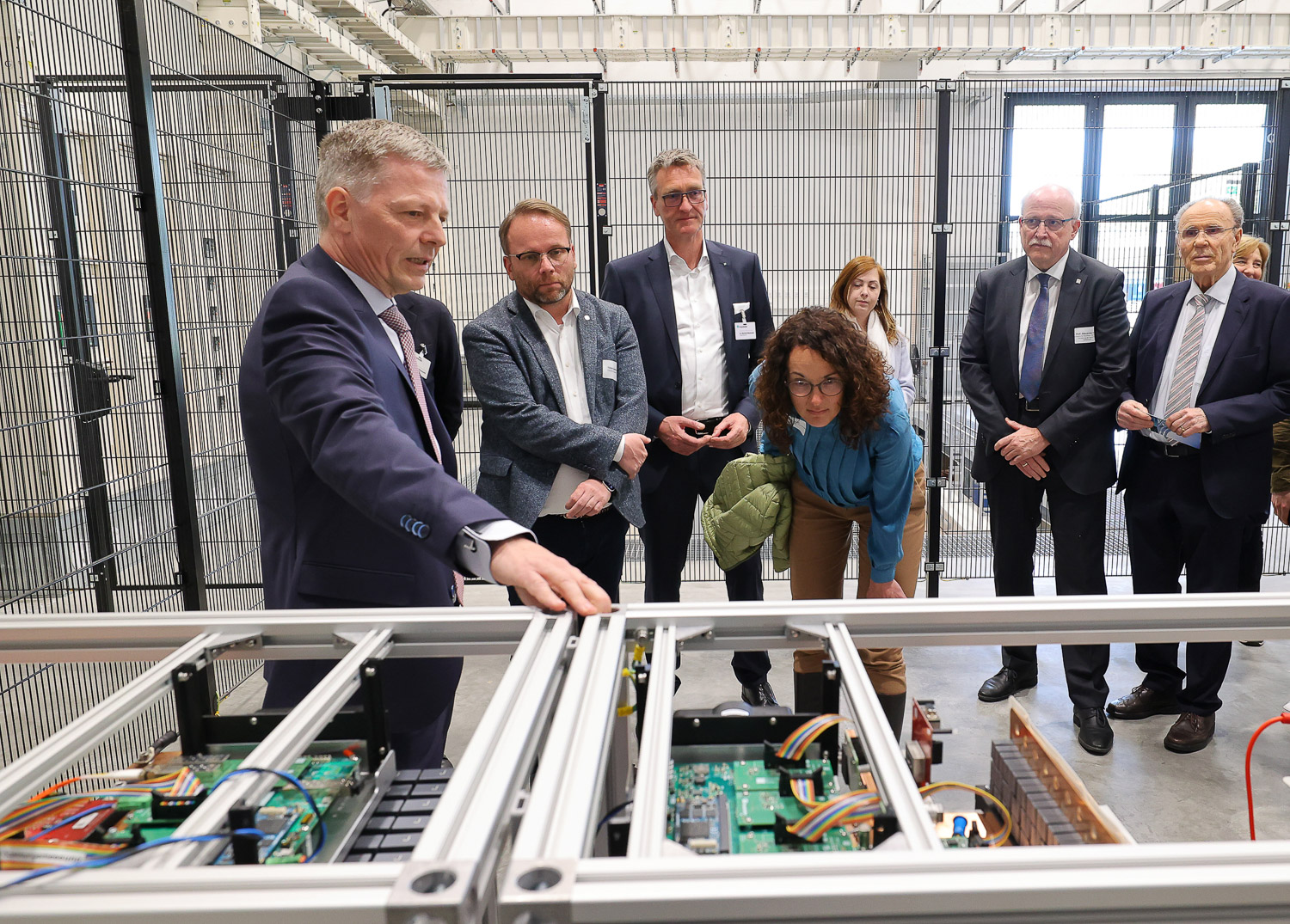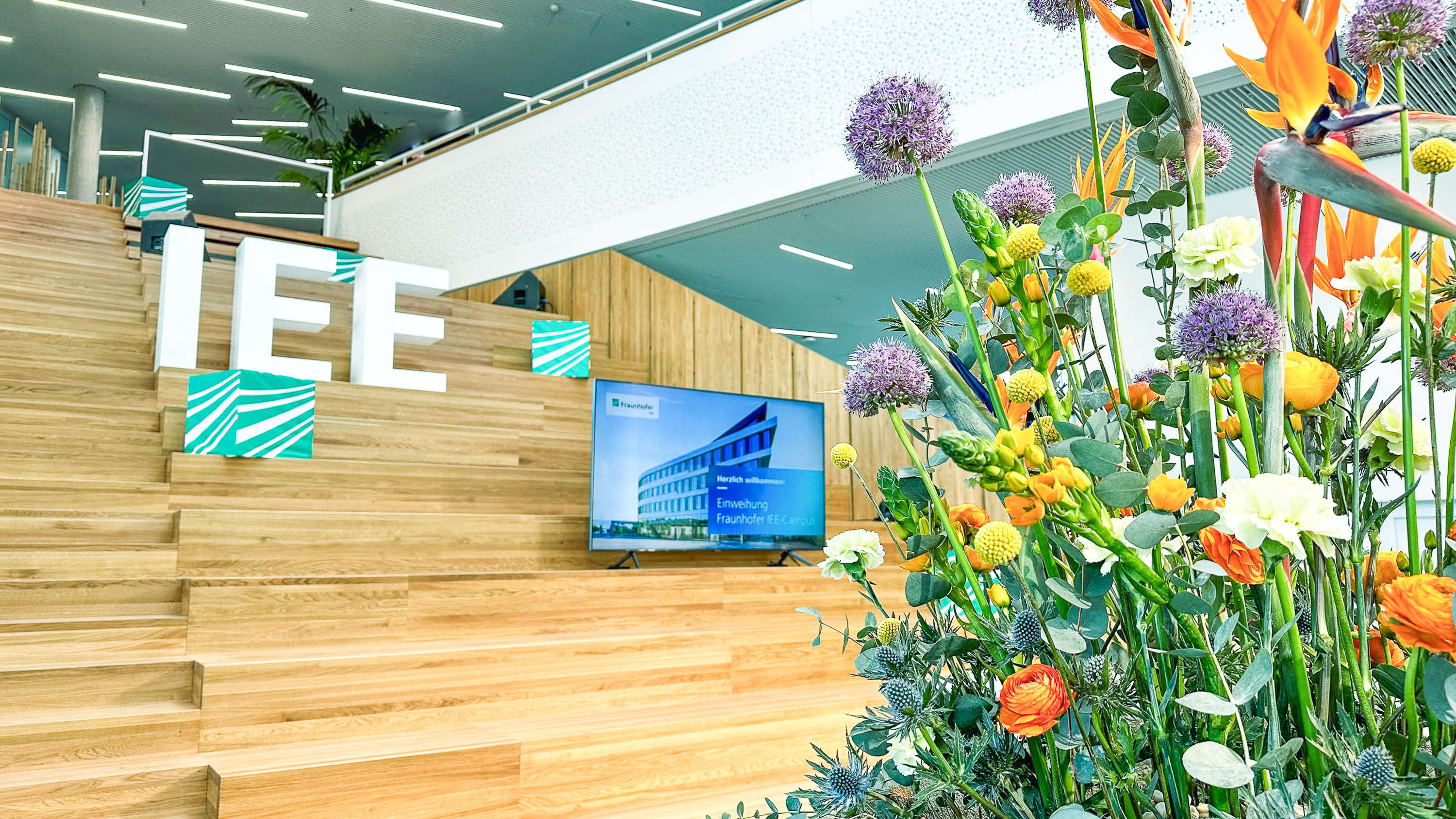Kassel, May 3rd, 2023
Fraunhofer IEE celebrates its new campus and anniversary
Hesse's Minister of Science and Arts, Angela Dorn, Fraunhofer Executive Board Member, Alexander Kurz, and Kassel's Head of Building and Construction, Christof Nolda, together with over 300 selected guests from the fields of business, science, politicspolitics, and the public celebrated the inauguration of the new Fraunhofer IEE campus in Kassel today as well as the institute's 35th anniversary. The Federal Ministry of Education and Research and the state of Hesse have invested almost 70 million euros in the new building.



A new central research environment has been created in Kassel for the now 450 employees of the Fraunhofer IEE. A large technical center with specialist laboratories for power electronics, power converters, medium-voltage technology, battery systems, hydrogen, heating networks and digital network control technology now opens up extended opportunities to support the economy through applied research in these important fields of innovation. The researchers moved into the new building with 325 office workstations, the technical center and laboratories a year ago.
In order to provide the institute with sufficient space for its further development, the city of Kassel acquired the former customs area north of Deutsche Bahn's main railway station, developed it as a building site and then sold two thirds of it to the Fraunhofer-Gesellschaft for the new building.
In her welcoming speech, Angela Dorn, Hessian Minister for Science and Art, said: "Russia's war of aggression against Ukraine at the latest has shown how dependent we are on fossil fuels. In order to succeed in the energy transition, we need future-oriented research that continuously develops technology. The Fraunhofer Institute for Energy Economics and Energy Systems IEE is working on these current pressing challenges - now even more effectively. The new building brings together the institute's departments, which are spread across Kassel, and provides new space for further technical developments. The state of Hesse is investing around 34 million euros in an important driver of innovation and thus also in the fight against the climate crisis.
Angela Dorn paid tribute to the research work conducted in the entire North Hesse region with the following statement: "Today we are also celebrating 35 years of cutting-edge applied research in the field of renewable energies and energy system technology. The IEE's research has driven the development of these technologies and made them more efficient, reliable, and cost-effective. Thanks to the work of the IEE, other Fraunhofer Institutes and the University of Kassel with its focus on engineering and environmental science, North Hesse has become the leading region in the field of environmentally friendly energy systems."
The work of these researchers is in great demand in the light of the climate protection challenges posed by the accelerated expansion of renewable energies. Fraunhofer IEE is an important player in Fraunhofer energy research with over 2,000 employees in 19 Fraunhofer Institutes, which pool their expertise in the Fraunhofer Energy Alliance, one of the largest energy research institutions in Europe. "As a leading institute for research and development in the field of renewable energies and the energy industry, the IEE has achieved numerous accomplishments in recent years," said Fraunhofer Executive Board member Prof. Dr. Alexander Kurz in his welcoming address.
Fraunhofer IEE focuses on research issues in the fields of energy informatics, energy meteorology and geoinformation systems, energy economics and systems analysis, energy process engineering and storage, grid planning and operation, grid stability and power converter technology as well as thermal energy technology in order to drive forward the energy transition. "We are researching towards a resilient, stable and affordable energy supply with renewable energy that is coupled across all sectors and controlled by automated processes with artificial intelligence," says acting Institute Director Dr. Reinhard Mackensen.
Foundation and development
For 35 years, Fraunhofer IEE has been working under the motto "Shaping the energy transition" to develop solutions and answers to technical and economic questions in the field of renewable energies. It develops solutions for technical and economic challenges in order to further reduce costs, secure supply, ensure grid stability, advance digitalization in the energy industry and enable new business models with respect to the energy transition.
The institute's name has changed twice over the years: it was founded in 1988 as the Institute for Solar Energy Supply Technology ISET, then integrated into the Fraunhofer-Gesellschaft in 2009 as part of the Fraunhofer Institute for Wind Energy and Energy System Technology IWES, before becoming the independent Fraunhofer Institute for Energy Economics and Energy System Technology IEE in 2018.
In a panel discussion, Prof. Dr. Werner Kleinkauf recalled his intention that led to the founding of the Institute for Solar Energy Supply Technology ISET in 1988: "After the first oil price crisis in 1973, a general questioning of fossil fuels began. In the large-scale study 'Energy sources for tomorrow?', which was financed by the federal government and carried out jointly by the Jülich nuclear research facility and the German Aerospace Center (DLR) in 1975, we were able to demonstrate that renewable energy sources, e.g., wind and solar energy, offer great, usable potential. My goal after moving from DLR to the University of Kassel was to advance systems engineering - the engineering understanding of the complexity of these new supply systems and structures - in addition to the basic research carried out in several research institutions throughout Germany."
Highlights
Institute Director Reinhard Mackensen gave the following examples of highlights from 35 years of research on the use of renewable energies: "From a personal perspective, it is the further development of forecasting systems, virtual power plants and everything to do with the digitalization of the energy industry - in particular the use of artificial intelligence methods.
Looking at the institute as a whole, there are many other highlights, for example:
- Power electronics, which we developed for photovoltaics in the 1990s and for which we are now providing new impetus for material savings and control processes for industrial innovations.
- Battery simulation, which has been used worldwide in the automotive and supplier industry for decades and is constantly being developed further.
- Marine energy, in which we played a key role in the world's first large-scale marine current turbine pilot plant off the west coast of England.
- The StEnSea project, in which we developed and built the first pilot plant for a marine pumped-storage power plant on a scale of 1:10 and successfully tested it on the bottom of Lake Constance.
- In the field of bioenergy, we were an early advocate of its flexible use and developed processes for demand-driven biogas production.
- We are developing reactor and plant concepts as well as operating models and optimization processes for power-to-gas as long-term storage.
- With the global Power-to-X Atlas, we show the worldwide potential for importing green hydrogen and other renewable e-fuels.
- We are developing expansion scenarios and new grid expansion planning methods for the expansion of transmission and distribution grids.
- For the sector coupling of electricity, heat and mobility, we are developing processes and business models for cross-sector supply structures and storage systems."
Last modified:
